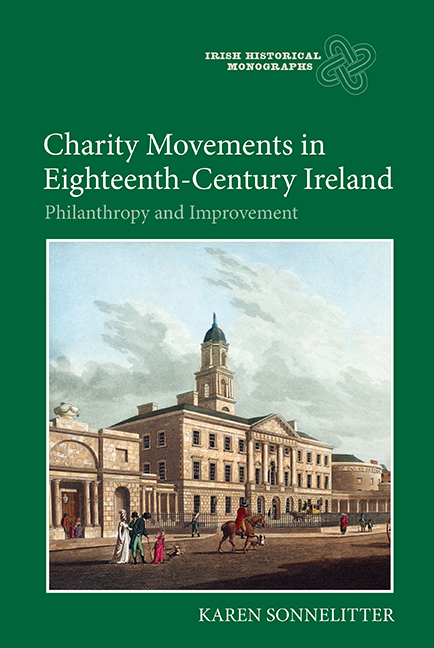Book contents
- Frontmatter
- Dedication
- Contents
- List of Figures
- Acknowledgements
- Abbreviations
- Introduction: Ireland in the Eighteenth Century: The Case for Improvement
- 1 ‘The Worst in Christendom’: The Church of Ireland and Improvement
- 2 Education and Charity: The Incorporated Society for Promoting English Protestant Schools in Ireland
- 3 To Cure and Relieve: Voluntary Hospitals in Eighteenth-Century Dublin
- 4 Improvement as Philanthropy: The Royal Dublin Society
- 5 ‘The Benevolent Sympathies of the Female Heart’: Women, Improvement, and the Work of Lady Arbella Denny
- 6 National and Local Government and Improvement
- Conclusion: Philanthropy and Improvement in Eighteenth-Century Ireland and Beyond
- Bibliography
- Index
1 - ‘The Worst in Christendom’: The Church of Ireland and Improvement
Published online by Cambridge University Press: 11 May 2021
- Frontmatter
- Dedication
- Contents
- List of Figures
- Acknowledgements
- Abbreviations
- Introduction: Ireland in the Eighteenth Century: The Case for Improvement
- 1 ‘The Worst in Christendom’: The Church of Ireland and Improvement
- 2 Education and Charity: The Incorporated Society for Promoting English Protestant Schools in Ireland
- 3 To Cure and Relieve: Voluntary Hospitals in Eighteenth-Century Dublin
- 4 Improvement as Philanthropy: The Royal Dublin Society
- 5 ‘The Benevolent Sympathies of the Female Heart’: Women, Improvement, and the Work of Lady Arbella Denny
- 6 National and Local Government and Improvement
- Conclusion: Philanthropy and Improvement in Eighteenth-Century Ireland and Beyond
- Bibliography
- Index
Summary
On 17 July 1690 Queen Mary II of England wrote to her husband, King William III, who was with his army in Ireland. William had recently won a significant victory over his father-in-law, James II, at the Battle of the Boyne and, while final victory over the Jacobite forces in Ireland would take another year, the victory at the Boyne effectively secured William and Mary's reign in Ireland. Mary wrote to her husband of her joy at the news of his victory, but also mentioned to him a matter that deeply concerned her: the Church of Ireland. ‘I must put you in mind of one thing, believing it now the season, which is, that you would take care of the church in Ireland. Everybody agrees that it is the worst in Christendom.’
Mary did not expand much on what made the Church of Ireland ‘the worst in Christendom’ other than the large number of vacant bishoprics at that time. However, she was hardly alone in noting that the Church of Ireland was deeply troubled. Henry Hyde, earl of Clarendon, wrote in 1686, during his tenure as Lord Lieutenant, that ‘the state of the church is very miserable … very few of the clergy reside on their cures, but employ pitiful curates which necessitates the people to look after a Romish priest or a Nonconformist preacher, and there are plenty of both’. Clarendon was especially concerned with the large numbers of non-resident clergy at all levels of the Church. He complained that John Vesey, archbishop of Tuam, had been absent for three years, while Thomas Hacket, bishop of Down and Connor, had been absent for six. Non-residency and pluralism were some of the problems afflicting the Church of Ireland at the end of the seventeenth century and, by the eighteenth century, the situation had not changed. The position of the Anglican Church as the legally established state Church of the island was made more secure with William III”s victory, but this did little to solve the problems of poverty, pluralism, and non-residence that affected the Church.
The Church of Ireland in the eighteenth century was something of a contradiction.
- Type
- Chapter
- Information
- Charity Movements in Eighteenth-Century IrelandPhilanthropy and Improvement, pp. 25 - 46Publisher: Boydell & BrewerPrint publication year: 2016



